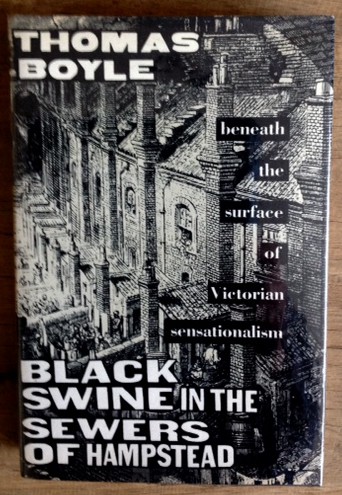Inspiring Older Readers
 posted on 14 Sep 2017
posted on 14 Sep 2017
Black Swine In The Sewers of Hampstead by Thomas Boyle
Thomas Boyle (not to be confused with the more high profile T.C. Boyle) is an American crime novelist and so it’s not surprising that he’s fascinated by the inter-relationship between the early days of newspaper sensationalism and the popular crime fiction of that time. His 1989 publication is an entertaining, if not terribly well written, book about this subject that benefits from his often quite substantial verbatim reproduction of some of the most lurid Victorian news copy I’ve ever read. I was, for example, captivated by the report of a Mr Lyle who seems to have developed something he called a 'crimeonometer' that would fit under his bed and which would monitor his wife’s infidelity and liaisons.
The idea for this particular book springs from an earlier unfinished PhD which was suddenly kicked back into life when the author was given several volumes of bound newspaper clippings which provided details of some of the more bizarre cases that found their way to the Victorian courts. This made Boyle able to look back to the birth of the popular newspaper in the early Victorian period and – surprise, surprise – he found that their staple diet very quickly became lurid tales of crime, murder and sex. Plus ça change, plus c'est la même chose.
But there’s no denying that there is a fascination in reading these contemporary accounts of sensational events – they may not differ much from today’s red-tops in the kind of stories they seek out but there are huge differences in the journalism, which has to paint pictures in words rather than rely on the services of the house photographer or paparazzi.
It is this element of story-telling which clearly provides the link between the emergence of the sensationalist press and the first golden age of Victorian crime writing and the best seller phenomenon that surrounded Dickens, Wilkie Collins and Charles Reade.
At the heart of Boyle’s thesis is the notion that we’ve wrongly stereotyped the Victorians as fusty, buttoned-up prigs who have a fit of the vapours every time sex or violence is mentioned in public. Quite to the contrary Boyle would claim that there was a sort of popular obsession with these subjects and that bled across into all forms of popular culture – including novels.
A review of the book on the History Today website by Clive Emsley notes that:
From the reports of the trials Boyle moves into the interpretation of events and the criticisms of these reports which appeared in journals, and hence to an appreciation of 'sensation' novels such as Mary Elizabeth Braddon's Lady Audley's Secret and Wilkie Collins's convoluted Armadale. These novels Boyle argues, challenged the Victorian orthodoxy which sought to suppress passion, maintain separate gender roles, and proclaim the racial superiority of the Englishman. Moreover, with their fumblings towards naturalism and the exploration of the subconscious, he suggests they foreshadow the work of sceptical and experimental artists and thinkers of the turn of the century.
I think this book offers an interesting appendix to the, in my view, far superior Steven Marcus exploration of some similar issues in The Other Victorians or maybe Ronald Pearsall’s excellent The Worm In The Bud which offer a degree of interpretation and analysis this book gets nowhere near. Read it for the reproduction of the contemporary newspapers if for nothing else – I promise they will have you both appalled and amused at almost one and the same time.
Terry Potter
September 2017